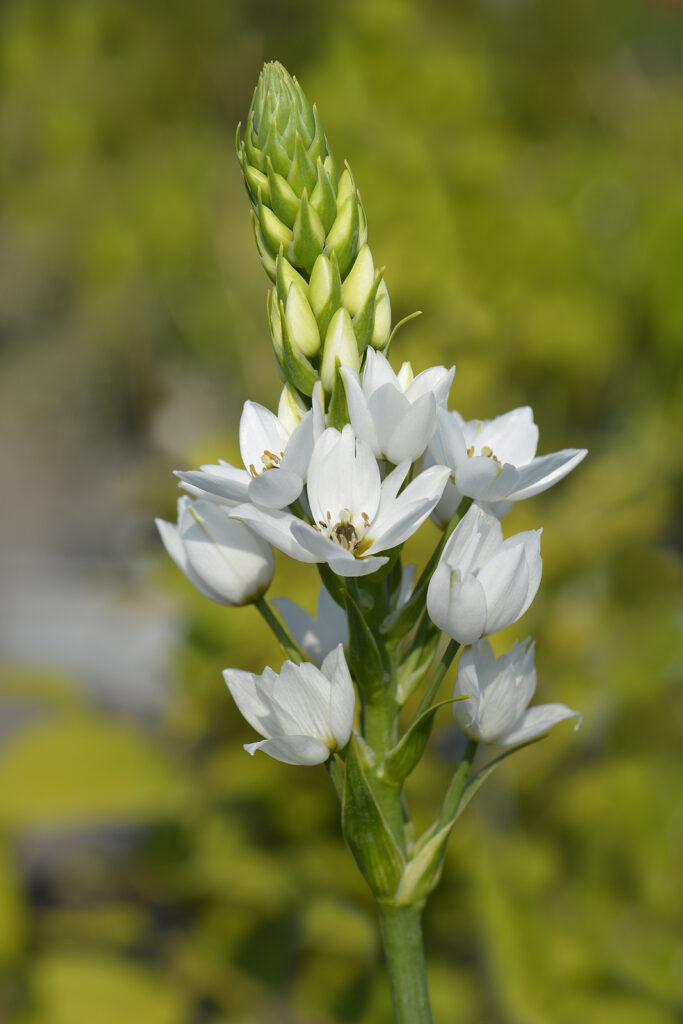Ornithogalum is commonly known as Star-of-Bethlehem for its clusters of typically star-shaped flowers. Ornithogalum species are hardy and tender bulbs that bloom from late winter to late spring depending on the species.
Ornithogalum grows from bulbs and bears basal leaves that range from narrow and linear to rounded and tend to droop. The starry blooms are usually white and are carried in either erect, spikelike racemes or rounded racemes that resemble umbels. Individual flowers consist of six petal-like tepals. The outer tepals are often striped with green on the outside.
In mild-winter regions, grow Ornithogalum in open woodlands and wild gardens, or rock gardens where they can naturalize. They are also showy container plants and can be massed in borders.
Where winters are cold, grow Ornithogalum in pots and force them for early flowering indoors or in the greenhouse,

Get to know Ornithogalum
- Plant type: Hardy and tender bulbs
- Growing zones and range: 4-10
- Hardiness: Require protection in cold-winter regions
- Height and width: 18 to 36 inches (45-91cm) tall and 18 inches wide
- Flowers: Star-shaped usually white flowers borne on erect, spikelike racemes or rounded racemes that resemble umbels
- Bloom time: Late winter to late spring
- Uses: Plant along shrub borders, naturalize in a meadow or grass, and in semiwild areas.
- Common name: Stars-of-Bethlehem
- Botanical name: Ornithogalum
- Family name: Liliaceae
- Origin: Central and South Europe and Mediterranean
Where to plant Ornithogalum
- Plant Ornithogalum in full sun or light shade.
- Grow Ornithogalum in average to rich, well-drained soil.
- Ornithogalum is marginally hardy; plant them in a warm, south-facing location in well-drained soil.
- In areas with summer rainfall, grow them in pots to keep them dry.

When to plant Ornithogalum
- Plant Ornithogalum bulbs in the garden in the fall.
- Plant Ornithogalum bulbs in spring where winters are wet.
- Plant Ornithogalum in containers where the soil stays wet; bulbs can easily rot in wet soil.
Planting and spacing Ornithogalum
- Set Ornithogalum bulbs 4 inches (10cm) deep.
- Space Ornithogalum 3 to 4 inches (7.6-10cm) or more apart.
How to water and feed Ornithogalum
- Keep the soil just moist, but not wet.
- Fertilize Ornithogalum with bulb food or all-purpose fertilizer at planting time and again each spring.
Ornithogalum care
- Mulch Ornithogalum heavily in late fall with evergreen boughs, salt hay, pine needles, or another coarse mulch.
- Ornithogalum produces many offsets and can become invasive if not monitored.
- Lift bulbs in late summer or fall where the soil is wet in winter; store them in a cool, dry place at 50°F (10°C).
- Bring container-grown plants indoors before the first frost to finish blooming indoors, then gradually allow them to dry out for overwintering.
Growing Ornithogalum as a houseplant
- Grow Ornithogalum in a cool room where light is direct and humidity is average.
- Plant bulbs in a soilless medium, and let the medium dry slightly between waterings.
- Fertilize monthly when the plant is growing or flowering.
- Ornithogalum does not require a chilling period.
- After the flowers have faded, water until the foliage turns brown; then let the medium dry out and place potted bulbs in a storage area over the summer and fall.
- In early winter, bright the pots into the house, start watering, and repeat the process.
Ornithogalum pests and diseases
- Ornithogalum is not bothered by insect pests.
- Leaf spot is a potential problem.
Ornithogalum propagation
- Ornithogalum produces an abundant number of offsets.
- Divide offsets in spring or fall and replant immediately.
- Ornithogalum can also be propagated by seed.
Ornithogalum varieties to grow
- Ornithogalum arabicum, star-of-Bethlehem. Grows 12 to 36 inches (30-91cm) tall and 18s inches wide; bears rounded racemes of 6 to 25 cup-shaped 1.5-inch wide, pearly white flowers that have a prominent black ovary in the center; flowers have a fruity fragrance; blooms in early summer.
- O. balansae, sometimes listed as O. oligpphyllum. Grows to 3 inches (7.6cm) tall; bears rounded racemes of 2 to 5 cup-shaped 1-inch wide flowers in shades of golden yellow, orange, red, or sometimes white; blooms from late winter to early spring.
- O. caudatum, sea onion. Grows 18 to 36 inches tall; flwoer are white with green midvien on the petals; blooms in clusters of up to 100.
- O. dubium. Grows 8 to 12 inches (20-30cm) tall; resembles O. arabicum but petals in shades of yellow and orange surround the beady black eye.
- O. nutans. Grows to 24 inches (61cm) tall with starlike to nearly bell-shaped white flowers striped with green on the outside and pronounced central cluster of stamens; up to 15 blooms along the upper part of each stalk.
- O. thyroides. Grows 18 to 24 inches (45-61cm) tall with elongated clusters of 2-inch-wide flowers with centers tinted with green or cream; excellent cut flower. Hybrids include ‘Chesapeake Starlight’ and ‘Chesapeake Snowflake’, both are a good choice for containers.
- O. umbellatum. Grows to 12 inches (30cm) tall and bears clusters of inch-wide white flowers striped-green on the outside; grassy-looking leaves; good for cut flowers.















